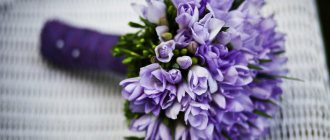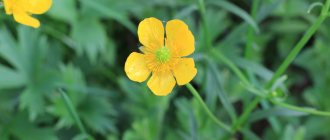In the fall, the garden prepares for the coming winter, with many plants shedding their leaves and preparing to enter a state of dormancy. However, some species will help make our garden bright and beautiful even in late autumn. Find out what flowers bloom in autumn (September, October).
In October, autumn fully comes into its own. The leaves of trees and shrubs change colors and fall off. Fortunately, the garden is not so gloomy when it comes to flowering plants. In October, some annual and biennial plants, bulbous and tuberous plants and perennials bloom. Below are the most beautiful flowers blooming in autumn with photos and names. Meet the most popular autumn flowers.
Annuals and biennials
Marigolds small-flowered
The most popular annual flowers blooming in October are marigolds.
The following marigold species bloom in October:
- small-flowered (Tagetes patula),
- thin-leaved (Tagetes tenuifolia),
- erect (Tagetes erecta).
There are more than 40 species of marigolds in total! As wild plants, they are found on both continents of America in tropical and temperate (warm) climate zones. Plants, depending on the species, grow to different sizes - usually 60 cm in height. The leaves are characteristic, small, highly pinnate with a serrated edge. Flowers appear in summer and persist until late autumn. Their size depends on the species (approximately 4-10 cm), yellow, orange and red-brown in color. They are very popular with pollinating insects, mainly bees.
Celosia silver
The annual plant Celosia belongs to the amaranth family. In nature, celosia is found in tropical regions of Africa and Asia, where it is considered a weed. All types of celosia are characterized by erect and compact growth.
The typical species for this genus is Celosia argentea. The plant grows up to 30 cm, and the inflorescence grows up to 50 cm. The leaves of the plant can be light green, dark green or slightly purple in color (sometimes with a spot in the center). They have an elongated lanceolate shape with a pointed apex. Tiny celosia flowers come in the following colors: white, yellow, pink, red, purple. They are collected in characteristic colorful inflorescences.
Zinnia graceful
A beautiful plant that blooms in October is Zinnia elegans, which belongs to the Asteraceae family. It comes from Mexico and is very popular in Europe. Can reach 1 m in height. It has a stiff, straight stem covered with leaves. Zinnia leaves are oval, elongated, sometimes with a heart-shaped base, and light green in color. Graceful zinnia flowers are called basket-type inflorescences of exceptional beauty. They reach a diameter of several centimeters and come in the following colors: yellow, pink, orange, purple, red, white.
Brachycoma iberisolifolia
If you're looking for flowers that bloom all summer into fall, Brachycoma is a great choice. An autumn-blooming annual, Brachycome iberidifolia, belongs to the Asteraceae family. Found naturally in Australia. It has an erect, highly branched stem, grows up to 40 cm. The stems are thin, the leaves are small and narrow. Inflorescences - baskets with a diameter of 2.5 cm, reminiscent of daisies - appear abundantly from June to late autumn. Flowers are white, pink, pink-purple or blue.
Gatsaniya sparkling
The genus Gazania belongs to the Asteraceae family - Gazania splendens comes from southern Africa. These are mainly perennial plants, but in our climate they are grown as annuals. Grows up to 30 cm. Gatsania shoots are thick, often branched. The leaves are collected in inflorescences, elongated, dark green.
Chinese carnation
An annual plant (rarely biennial) belonging to the clove family (Caryophyllaceae) is the Chinese carnation (Diantyhus chinensis). It is found naturally in Asian countries (including China and Nepal). Carnation has an erect stem, reaches 40 cm. The leaves are narrow, lanceolate. Quite large flowers with jagged petals have a variety of colors - white, pink, red, scarlet, cherry, two-color.
Heliotrope
The annual Peruvian heliotrope (Heliotropium peruvianum) occurs naturally in Peru. A shrub plant reaching 20-90 cm in height depending on the variety. The leaves are large, ovate, pubescent. The inflorescences consist of many tiny, tubular, strongly scented (like vanilla) flowers. Blooms from July to autumn. The flowers are purple, blue, white.
Cleome
A rather large flower, Cleome spinosa, is found naturally in South America. Reaches 80-150 cm. Palmate leaves develop abundantly on strong shoots. Strongly fragrant, four-petaled flowers with long stamens are collected in lush, loose clusters. Cleome usually blooms purple, pink or white. The flowering period is from July until frost, often blooming in October. These flowers have a rather exotic appearance. The fruit is a long pod.
Cosmea bipinnate
Cosmos bipinnatus is found naturally in many regions of the world - North and Central America, Asia, and the Caribbean. This species is very popular in cultivation. Cosmea grows up to 1-1.2 meters in height. The leaves are small, terry-pinnate, light green. The flowers are collected in large baskets with a diameter of about 9 cm. The outer reed flowers are usually white or pink, the tubular flowers (in the center of the basket) are yellow. Cosmea blooms profusely from July to October.
Lobelia erinus
Lobelia erinus, a small annual plant belonging to the Campanulaceae family, is native to South Africa, where it grows in wet meadows. Lobelia forms dense bushes and carpets. The length of the shoots is 20 cm. It has small, sometimes glossy leaves, blooms profusely with flowers of purple, blue, white, pink, and red. Lobelia blooms from spring to autumn.
Calendula officinalis
Marigold or calendula (Calendula officinalis) comes from the Mediterranean and Iran regions. These autumn flowers have a straight, rigid stem that branches quite widely. The leaves are sessile and cover the stem. Calendula flowers are yellow-orange.
Impatiens Valleriana
A genus of annual or perennial plants, Impatiens valerian, is most common in tropical and subtropical regions of Africa and Asia. Several species are known to be invasive.
Castor bean
The tall castor bean (Ricinus communis) is found naturally in Africa; in our country it is grown as an annual. Reaches 150-300 cm. Forms thick stems on which leaves grow in a row, similar to chestnut leaves. Blooms from July; yellow or green castor bean flowers are not very decorative. After flowering it produces red, spiny decorative fruits.
Amaranth tailed, foxtail
Tailed amaranth (Amaranthus caudatus), 40-100 cm high, belongs to the amaranth family. Forms a wide bush with reddish shoots and ovate green, purple or tricolor leaves. Amaranth flowers are most decorative at the end of June - October, when large hanging inflorescences-panicles of different shades of red are formed (there are also varieties with green and purple flowers).
Winged tobacco
Nicotiana alata or winged tobacco belongs to the nightshade family (Solanaceae). Found in the wild in southern Brazil. Tobacco usually grows to 80-120 cm in height and has strong branches. Twisted sessile leaves form rosettes. The flowers are five-petaled, funnel-shaped, collected in loose panicles, exude an intense aroma, open in the evenings and close during the day. Tobacco blooms from July to September or October.
Kermek notched
Limonium sinuatum or Kermek notched is found in the wild in southern Europe, the Canary Islands, and northern Africa. It has erect sockets. Kermek grows up to 60 cm in height. The leaves are pinnately lobed and pubescent. Blooms from July to October. Tiny flowers are collected in majestic panicles. Flowers are white, yellow, pink, red, purple or blue.
Ageratum Huston or Gauston
Ageratum houstonianum is an annual or biennial plant found growing wild in Mexico. It has a spherical or straight shape with small heart-shaped leaves. The ageratum flower is popular due to its abundant and long-lasting flowering. Dense flowers, collected in a basket of purple-pink, violet (less often white), appear in June and decorate the plant until the first frost.
Autumn flowers in landscape design (video)
You can find tips for each bush:
- In the flowerbed, croxomia is planted in the last row. When blooming, the stems stretch out, the abundance of buds makes the branches heavy, they bend and cover the plants, which have already lost their attractiveness.
- Helenium is not afraid of cramped spaces, it can be placed in any area, it will carve out a place for itself and create an island.
- Amaranths are planted in a thin strip along buildings. They will decorate withered greenery with weeping panicles.
Fall flower beds can be just as charming as summer flower beds. The main thing is to choose the right plants. The variety of autumn varieties is as rich as the summer bouquets familiar to summer residents.
Bulbous and tuberous
Begonia tuberous
The bulbous perennial Begonia tuberhybrida was created by crossing many species of begonias from South America and the Andes. Tuberous begonia has an asymmetrical shape, reaches about 20-30 cm. The stems of the plant are straight (in some varieties they hang down), fleshy. The leaves are heart-lanceolate, uneven at the base, strongly toothed.
Dahlia
Garden dahlias (Dahlia x cultorum syn. Dahlia hybrida) are very popular flowering plants in September and October. They belong to the Asteraceae family. This is a hybrid species and is not found in nature. Depending on the variety, you can find dahlias reaching from 20 to 200 cm. The plant produces feathery, oval, pointed leaves with a strongly jagged edge of the leaf blade. Large baskets of inflorescences can be simple, semi-double or double. Some varieties reach 30 cm in diameter and have an extremely wide range of colors - yellow, orange, red, lavender, dark purple, pink, white or greenish. The flowering period begins in July and ends in October.
Canna
These plants grow in America and Asia. The Latin name comes from the Greek word Canna, meaning reed, as the plants have similar tall stems. This is a tall perennial: it grows from 100 cm (low varieties) to 150 cm (medium varieties) and more than 150 cm (tall varieties). The plant forms a thick branched rhizome, from which fleshy shoots with large leaves grow. The leaves are ovate-lanceolate, green or reddish-brown. At the ends of the shoots, colorful flowers of different shapes and sizes are formed. The flowers can be lemon yellow, carmine, salmon pink, orange-red, orange, yellow or dark scarlet.
Autumn colchicum
The bulbous plant autumn crocus (Colchicum autumnale syn. Multiflorum) is found in foothill meadows. Due to its close resemblance to the crocus, it is often confused. Unlike the crocus, its flowers are slightly larger with 6 stamens (the crocus has 3). This is a perennial plant that can reach 30 cm. The leaves are wide, lanceolate, glabrous, appearing in the spring along with the fruits. The plant produces up to 4 leaves about 20 cm long.
Criteria for choosing flowers for the garden that bloom in autumn
The main criterion for choosing flower crops is the variety of colors. Homeowners want their garden to be a rainbow of colors. Moreover, I want to admire it for more than one month, but from the first sunny days to light snowflakes. Selection criteria shared by experienced gardeners:
- Ease of care. Most of the plots are located in suburban areas. Summer residents come to visit them on weekends. Plants that require daily care may die. Varieties have special watering requirements; they must withstand drought, rain and hot sun.
- Disease resistance. Those species are selected that are not susceptible to most diseases. Pests are also being studied.
- Connection of perennial and annual plants in the area . Each variety has its own advantages, which should be used.
- Stem location and plant height. Low bushes require a place that will be easily visible. High ones must be maintained, that is, placed near walls and fences. The stems can curl and stretch across the surface. They also require a special place on the site.
Perennials
Bush aster
The most popular perennials that bloom in October are bush asters (Symphyotrichum dumosum). This is a low ornamental perennial plant of the Asteraceae family, native to North America, grown in many countries around the world. The bush grows up to 40-80 cm in height, forms hard, smooth, branching shoots at the top, covered with narrow-lanceolate, green, oblong leaves, wider at the bottom of the shoot and smaller, almost needle-like at the top. It blooms in late summer until frost (August-October), developing large, colorful, basket-like, honey-bearing flowers with a yellow center, located singly at the tips of the shoots. After flowering, the flowers form seeds, collected in dense fluffy basket-shaped inflorescences.
New England aster
These popular perennial flowers bloom late in the fall. American or New England aster (Symphyotrichum novae-angliae) is a tall, impressive perennial, growing up to 2 m. The plant produces tough, branched, strong, erect stems. The stems are densely covered with narrow, lanceolate, long, green leaves. Shoots and leaves are pubescent. At the end of summer and autumn (August-October), numerous basket-shaped flowers develop on the tops of the shoots, collected in dense large inflorescences of white, purple, pink or red.
Helenium hybrid
Helenium x hybridum is a perennial plant from North America. Flowering begins in late summer and ends in autumn (August - October). Grows well in fertile, light, moderately moist soils. Loves sunny positions. These perennials are propagated by sowing seeds and dividing bushes. You should not replant them in the fall - poorly rooted plants will probably freeze.
Yarrow
Lamb grass (Achillea millefolium) or common yarrow reaches a height of 80 cm. The perennial blooms for a very long time, from June to October. Tiny baskets of flowers are collected in flat inflorescences. This species has many interesting varieties with different flower colors (intense red, pink, white).
Coreopsis grandiflora
It is a short-lived perennial that is grown seasonally. An erect plant that forms tufts of lanceolate leaves with long stems reaching a height of up to 90 cm. Coreopsis flower baskets with a diameter of 4-6 cm are yellow. This garden flower blooms until late autumn, and blooms already in June. Loves well-drained sandy loam soils with average nutrient content. Blooms most profusely in sunny places.
Sedum or sedum prominent
Sedum spectabile or sedum is native to East Asia and Japan. The stems of the plant are straight and thick - they grow up to 50 cm. The plant is a leaf succulent, has leaves adapted for accumulating water - large, oval, light green, with a jagged edge. The flowers are collected at the top of the stem, ranging in color from white-pink to dark red. The plant blooms from late August to October.
Rules for placing autumn flowers in a flower bed
Plants are placed in plots not randomly, but in a special way. Order is required not so much for beauty as to enable flowers to reach full maturity. When composing flower arrangements, many characteristics are taken into account:
- flowering time;
- property to grow;
- accessibility for weeding.
Some flowers will help highlight lawns and hide outbuildings. Others will begin to delight immediately after the snow melts. They often try to hide the autumn blooms a little, that is, plant them further away, behind those varieties that will bloom earlier. Each plant has its own place and soil type.
Dahlias
When: there is no need to rush into harvesting: as soon as the first light frosts touch the leaves, we dig them out within three days. This way the tubers will ripen better. I don’t prune the main trunk in advance, because I need to remove moisture from the cut, cover it with foil from the rain, and I’m too lazy. In 3-4 weeks you need to stop feeding, make sure that the roots are not washed away by rain, and hill up if necessary.
Fig 4. Procyon dahlia a month before digging
How: You can dig on a rainy day. Step back from the bush, carefully dig around it, then pull it out. Remove excess soil with your hands rather than with a shovel, as the neck of the tuber is very fragile after removal. It is better to fold and take away not immediately, but to dry it for at least a couple of hours, then the neck of the tubers will become limp after a while and will not break during transportation and processing. You need to leave 8-10 cm of the stem. Don't be afraid to damage the roots.
To rinse or not: at the dacha you can rinse with a stream from a hose, and at home again, more thoroughly, under the tap. Leave to harden the skin for 4-5 days.
Rice. 5. I dry dahlia tubers on the windowsill near the open window.
Processing before storing: the tubers, in an amicable way, need to be divided. But, since I don’t cut off the stem in advance, thereby giving a start to the growth of new eyes, I don’t divide them, I store them in groups. And then, if you don’t leave a piece of the neck with the buds, then in the spring they won’t germinate. That's why I don't take risks, especially since the eyes are completely invisible. All I do is cut the stem as low as possible, wipe the knife with alcohol after each cut, remove the top small tubers - they are not ripe anyway, as well as all the branches of the roots. After this, you need to rinse again and cut the ends of the tubers. The cuts should not be brown. A rusty cut is a sign of damage, then we cut it higher. If more than half of the tuber remains, it will go for storage. Treat by immersion in a fungicide solution for 15 minutes. You can add insecticides. If a tuber floats on the surface of the solution, throw it away; it means it won’t survive until spring. If you drowned, good. After the processing time has expired, we take it out, mark the variety, and lay it out on cotton material.
Dry now or not: a day or a little longer.
Where to store: in a cellar or refrigerator in conditions of sufficient humidity, temperature not lower than 3 degrees. Place the tuber in a bag with vermiculite or large sawdust and close it loosely. Again, you can wax the whole tubers, but I haven’t tried it. This winter I want to try storing it in a cardboard box, layered with crumpled newspapers.
Care in winter: the main thing is not to allow the temperature to be warm, otherwise the dahlias will begin to grow, and this will weaken them. Maintain air humidity. In the refrigerator it is already high, but in the cellar - measure and adjust. Otherwise, the tubers will shrink and become unusable. Well, of course, no one canceled the monthly inspection for rot. We separate the parts that begin to rot and throw them away.
This year I tried to dig up annual dahlias. Some of the tubers turned out to be good, large, I hope that at least half will survive. In general, it is believed that dahlias are the most capricious in winter storage, since they need to constantly maintain a certain air humidity.
Rice. 6 Small tubers of annual dahlias obtained from seeds
After the primroses
When the first plants bloom, they can be successfully replaced by bright, low-growing flowers:
- lilac anemones;
- blue periwinkle;
- primrose.
Violas (multi-colored pansies) and variegated petunias have bright flowers; there are double varieties of all shades.
Even the most strict gardener will be surprised by the huge selection of tulips and daffodils.
Tulips. The following varieties of miniature tulips are very popular: “Urumiysky”, “Tarda” and “Little Princess”. The “Excellent” tulip is especially loved; it produces 3 scarlet flowers from 1 stem at once.
You also need to plant flowers in the flowerbed:
- imperial hazel grouse;
- lily of the valley;
- bearded irises.
With the onset of hot days, annuals bloom:
- Dee, there are many varieties of them, from huge bushes to small ones. Shades from white, yellow to red.
- Snapdragon - mini gladiolus with an armful of flowers in a wide range of shades;
- Iberis white - suitable for flower beds of contrasting colors;
- Daisies are lovely plants in all shades;
- Sky-colored nemophila is ideal for creative flower beds;
- Ageratum - with small purple or pink-blue flowers for lovers of low-growing plants. They will decorate the flowerbed with lush balls.
- Lobelia is ideal for creating a blue-violet background in a flower bed. Many small flowers will cover the soil.
Gladioli
When: we dig early varieties on a fine day, 4-6 weeks after cutting (or after they bloom), late varieties - 6-7 weeks. If the peduncle is released too late, then it is better to cut it in advance, at least a month before digging. It will bloom successfully in a vase at your home.
Fig.1. These gladioli did not even think of blooming on September 5, when I brought them home. But that's what happened on September 10th. And so they bloomed until the 22nd!
How: We dig dark-colored and bluish varieties first; they have less resistance to fungal diseases
Carefully dig up with a shovel, put it in a bucket, and then pre-cut it 3-4 cm from the neck
Lastly, we remove what has grown from the children planted in the spring.
Rice. 2. In order not to lose the children from the main bulb, we put the trimmed ones in a basin.
To rinse or not: I always wash it at home in running water. I throw away the affected bulbs. If the variety is valuable and there are traces of thrips, you can try pickling it in an insecticide solution. If the leaves were “suspicious” before digging, you can apply fungicides. And healthy specimens can be placed in a weak solution of potassium permanganate for half an hour.
Rice. 3. I cut the neck again, because the house is cleaner and the processing conditions are better than at the dacha. I also chik the roots a little.
To dry or not: of course, you can dry it at room temperature. I periodically inspect it for about two months and turn it over. The varieties should be signed, but I always forget.
Treatment before storing: if during storage any bulb becomes sick, you can cut off the infected area with a clean knife and cover it with brilliant green. But it is better to store only the most beautiful healthy onions, otherwise they will re-infect each other. And, of course, we separate the old onion along with the roots. If you wish, you can paraffinize the material before storage - dip it in molten paraffin for a couple of seconds. In the spring they don’t clean it off, they plant it right in this spacesuit. It seems that gladioli are stored better this way, but I haven’t tried it. I do not separate the neck and old peel, because of this the bulbs will dry out.
Where to store: I tried storing it in the pantry at home, in an ordinary cardboard box, sprinkled with ash, but not all survived until spring. But they are stored better in the refrigerator, and without the hassle of ash. Only the box should be ventilated and made of thin cardboard, not thick. It can also be stored in a cellar if the temperature there is stable and does not drop below 2 degrees in severe frosts.
Winter care: I check at least once a month for fungal diseases, or, more simply, for mold. If a gray mold coating appears, then you need to dry the room or ventilate it, and add vermiculite or silica gel to the boxes. Wipe the diseased onions with something alcoholic, dry them, and put them back.
Primrose
Primrose belongs to the group of primroses. The herbaceous perennial has many varieties. Every year new, even more impressive varieties appear on the market. For best germination, you should take the freshest seeds. Primrose is sown before winter at the end of October.
The method of sowing in open ground is more suitable for varieties with large seeds. The soil for primroses should be loose and nutritious. The flower develops better when planted tightly. Only some varieties of primroses are light-loving; others grow better in the shade.
Beautiful ideas for creating a flower garden
The beauty of a flower bed depends on the correctly selected varieties, arranged in a certain pattern. But we must not forget about arranging the flower garden itself. A good solution would be to designate clear boundaries. You can use any available materials.
You can make an original flowerbed in the center of the site from wood. This could be a low fence made of boards or stumps, or hanging structures. To create flower beds of various heights, you can use stones and bricks. An “alpine slide” will fit perfectly into the landscape design.
The garden will be decorated with original flower beds made from old tires, furniture, and plastic bottles. You can use a rusting car that cannot be repaired, a metal mesh, or an old piano.
Rules of care
Autumn perennials are generally low-maintenance and do not require special attention.
Loosening
To allow moisture and air to reach the roots of the flower, the soil must be loose, so it is worth regularly cultivating the soil under the plants. To avoid damage, especially to low-growing varieties, you should carry out the procedure very carefully.
Top dressing
The plants are first fed in early spring, when the snow melts. Organic is well suited for these purposes. To increase green mass, fertilizers with nitrogen are used. Minerals are fed from the beginning of budding. In the fall, they stop adding nitrogen-containing compounds and feed them with potassium and phosphorus, which nourish the roots and prepare the plants for winter.
Watering
During rainy periods, plants do not need additional moisture; the rest of the time, once a week is enough for them.
Before wintering, it is worth moistening the flower generously once.
Weeding
They weed the bushes while loosening. The weeding procedure is mandatory, although in the fall the weeds do not grow much, they still choke the plants and take nutrients from the soil. This should be done manually to avoid damage to the flowers. To simplify the task, you can mulch the space between the plants. To do this, use dry grass, crushed bark of coniferous trees, small pebbles or expanded clay. The latter, in addition to their main tasks (preserving moisture and delaying weeds), also perform a decorative function, serving as an additional decoration for the flower bed.
Finishing touch
Perhaps it would not be amiss to paint our flowerbed with multi-colored zinnias. How, you don’t know what this is? Yes, these are “majors”! I am sure that this is the name by which these annual autumn flowers are known to everyone. Yellow, white, red, pink - they will give their color throughout September and, if the autumn was warm, October.
However, they were not included in our list of “amazing” autumn flowers for their color. It is thanks to them that butterflies and birds will flutter around our flower garden, which will become the final chord, the coda, of our flower garden, striking any imagination.
Well, we can talk about autumn colors endlessly. Even on asters or dahlias alone, in their photographs, you can linger so long that spring will come.
What about the ornamental grasses, which fluff up their spikelets in the fall so that you can’t take your eyes off them? There are so many types of miscanthus alone that you could plant an entire area. And what is autumn without the queen of flowers - the rose?
Maxim Kolesnichenko











